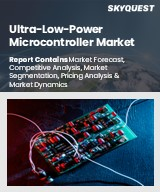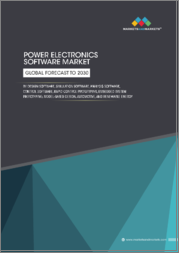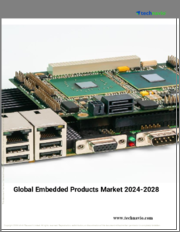
|
시장보고서
상품코드
1806383
임베디드 시스템 시장 : 컴포넌트별, 임베디드 시스템 유형별, 시스템 사이즈별, 용도별 - 세계 예측(2025-2030년)Embedded Systems Market by Component, Embedded Systems Type, System Size, Application - Global Forecast 2025-2030 |
||||||
임베디드 시스템 시장은 2024년에 1,043억 3,000만 달러로 평가되었습니다. 2025년에는 1,120억 4,000만 달러에 이르고, CAGR 7.56%로 2030년까지 1,615억 9,000만 달러에 달할 것으로 예측됩니다.
| 주요 시장 통계 | |
|---|---|
| 기준 연도 : 2024년 | 1,043억 3,000만 달러 |
| 추정 연도 : 2025년 | 1,120억 4,000만 달러 |
| 예측 연도 : 2030년 | 1,615억 9,000만 달러 |
| CAGR(%) | 7.56% |
급속한 기술 융합, 진화하는 산업계의 요구, 세계 관점의 변화 속에서 임베디드 시스템 혁신의 발판을 마련합니다.
임베디드 시스템 생태계는 하드웨어 인텔리전스와 소프트웨어 기능을 원활하게 통합하고 차세대 용도를 강화함으로써 디지털 전환을 실현하는 데 중요한 역할을 하고 있습니다. 커넥티비티에 대한 요구 증가, 엣지 컴퓨팅의 확산, 실시간 데이터 처리 요구의 가속화를 배경으로 각 업계 기업들은 제품 아키텍처와 서비스 제공 모델을 재구축하고 있습니다. 이 보고서의 서론에서는 디자인 우선순위, 공급망 구성, 최종 사용자의 기대치를 재구성하는 힘을 검토함으로써 그 단계를 설정합니다. 이 때, 처리 능력, 소형화, 저지연 통신 프로토콜의 발전이 상호 작용하고 있음을 강조하고 있습니다.
임베디드 시스템의 역학을 재정의하고, 최첨단 컴퓨팅, 연결성, 보안, 지속가능성의 융합을 보여줍니다.
임베디드 시스템은 여러 창조적 파괴의 흐름이 경쟁 구도를 재정의하는 변곡점에 도달했습니다. 인공지능 가속기와 도메인별 아키텍처의 급속한 성숙은 컴퓨팅 패러다임을 변화시켜 전례 없는 속도와 전력 효율로 추론 워크로드를 가능하게 합니다. 이와 함께 유비쿼터스 연결 표준의 확산(저전력 광역 네트워크에서 5G, 그리고 Beyond G까지)으로 엣지 생태계가 확대되면서 스마트시티, 자율 물류, 몰입형 소비자 경험 등 새로운 이용 사례를 위한 비옥한 토양이 형성되고 있습니다.
2025년 미국 관세 조정이 임베디드 시스템 공급망과 비용 구조에 미치는 광범위한 영향 검증
미국이 2025년 관세 일정을 재조정하기로 결정함에 따라 임베디드 시스템 공급망 전반에 걸쳐 비용 변동성이 높아져 전략적 불확실성이 발생하고 있습니다. 주요 반도체 부품, 메모리 장치, 특수 프로세서는 관세 분류 재검토 대상이며, 제조업체와 OEM은 조달 전략과 니어쇼어링 옵션을 재검토할 필요가 있습니다. 이러한 정책 전환은 파급 효과를 일으켜 기업들이 대체 공급업체를 평가하고 잠재적 혼란을 완화하기 위해 다단계 재고 버퍼에 투자하도록 촉구하고 있습니다.
시장의 하드웨어, 소프트웨어, 시스템 유형, 규모, 다양한 용도를 정의하는 중요한 세분화에 대한 통찰력을 제공합니다.
시장 세분화의 결과, 하드웨어와 소프트웨어의 두 축으로 정의되는 다면적인 상황이 드러났습니다. 하드웨어 측면에서는 입출력 인터페이스와 메모리 모듈, 전원 공급 장치, 디지털 신호 프로세서에서 범용 CPU, 마이크로컨트롤러, 마이크로프로세서까지 다양한 프로세서가 제공되고 있습니다. 한편, 소프트웨어 계층에는 저수준의 펌웨어, 중간 단계의 미들웨어, 본격적인 운영 체제 등이 포함되며, 이를 통해 시스템의 기능과 성능을 종합적으로 구성합니다.
북미, 유럽, 중동 및 아프리카, 아시아태평양 시장의 지역 역학, 성장 촉진요인, 전략적 고려 사항 정의
임베디드 시스템의 진화를 형성하는 데 있어 지역별 역학관계는 매우 중요합니다. 북미와 남미에서는 산업 시설의 급속한 디지털화와 함께 국방 전자 장비에 대한 정부의 적극적인 투자가 강력한 하드웨어와 안전한 통신 스택에 대한 수요를 촉진하고 있습니다. 기술 기업과 연구기관의 생태계 파트너십은 자율 이동과 스마트 인프라의 혁신을 더욱 가속화할 것입니다.
임베디드 시스템 분야의 혁신, 경쟁 전략, 파트너십 모델을 주도하는 업계 주요 기업의 주요 특징
임베디드 시스템 분야의 주요 업체들은 실리콘 설계, 소프트웨어 IP, 시스템 레벨 엔지니어링 서비스에 걸친 엔드 투 엔드 솔루션을 통합할 수 있는 능력을 갖추고 있습니다. 반도체 혁신가들은 신경처리에서 신호 컨디셔닝에 이르기까지 다양한 워크로드를 가속화하기 위해 특수 IP 코어와 이기종 멀티코어 설계를 진행하고 있습니다. 소프트웨어 벤더는 모듈형 개발 환경, 보안 툴체인, 다양한 프로세서 아키텍처에 맞게 확장 가능한 운영체제 배포를 통해 이를 보완하고 있습니다.
새로운 트렌드를 활용하고, 경쟁사 포지셔닝을 강화하며, 지속 가능한 성장을 가속하기 위한 업계 리더를 위한 전략적 제안
업계 리더들은 기술 혁신과 공급망 강건성, 규제와의 정합성을 모두 충족시키는 전략적 프레임워크를 우선시해야 합니다. 조직은 제품 라인 전반에 걸쳐 신속한 커스터마이징과 확장성을 촉진하는 모듈식 아키텍처 설계에 투자하는 것이 좋습니다. 개방형 표준을 채택하고 생태계 컨소시엄에 기여함으로써 상호 운용성을 가속화하고 통합 오버헤드를 줄일 수 있습니다.
시장 회복력, 기술 혁신의 필요성, 미래 성공을 위한 전략적 경로를 강조하는 주요 인사이트 통합
다각적인 조사 결과를 종합하면, 임베디드 시스템 시장은 급속한 기술 혁신과 복잡한 위험 요인을 특징으로 하는 매우 중요한 교차로에 놓여있다는 것을 알 수 있습니다. 첨단 프로세싱 아키텍처, 실시간 통신 프레임워크, 보안 요구 사항 증가는 상호 작용하여 각 산업에서 기회와 파괴를 동시에 가져오고 있습니다.
목차
제1장 서문
제2장 조사 방법
제3장 주요 요약
제4장 시장 개요
제5장 시장 역학
제6장 시장 인사이트
- Porter's Five Forces 분석
- PESTEL 분석
제7장 미국 관세의 누적 영향 2025
제8장 임베디드 시스템 시장 : 컴포넌트별
- 하드웨어
- I/O 인터페이스
- 메모리 디바이스
- 전력
- 프로세서
- 디지털 신호 프로세서(DSP)
- 범용 프로세서(GPP)
- 마이크로컨트롤러
- 마이크로프로세서
- 소프트웨어
- 펌웨어
- 미들웨어
- 운영체제
제9장 임베디드 시스템 시장 : 임베디드 시스템 유형별
- 모바일 임베디드 시스템
- 네트워크화 임베디드 시스템
- 실시간 임베디드 시스템
- 하드 실시간 임베디드 시스템
- 소프트 실시간 임베디드 시스템
- 스탠드얼론 임베디드 시스템
제10장 임베디드 시스템 시장 : 시스템 사이즈별
- 복잡한 임베디드 시스템
- 중규모 임베디드 시스템
- 소규모 임베디드 시스템
제11장 임베디드 시스템 시장 : 용도별
- 항공우주 및 방위
- 자동차
- 첨단 운전 지원
- 인포테인먼트
- 텔레매틱스
- 소비자 일렉트로닉스
- 에너지 및 유틸리티
- 헬스케어
- 산업
- 공장 자동화
- 프로세스 제어
- 로봇 공학
- IT 및 통신
제12장 아메리카의 임베디드 시스템 시장
- 미국
- 캐나다
- 멕시코
- 브라질
- 아르헨티나
제13장 유럽, 중동 및 아프리카의 임베디드 시스템 시장
- 영국
- 독일
- 프랑스
- 러시아
- 이탈리아
- 스페인
- 아랍에미리트(UAE)
- 사우디아라비아
- 남아프리카공화국
- 덴마크
- 네덜란드
- 카타르
- 핀란드
- 스웨덴
- 나이지리아
- 이집트
- 튀르키예
- 이스라엘
- 노르웨이
- 폴란드
- 스위스
제14장 아시아태평양의 임베디드 시스템 시장
- 중국
- 인도
- 일본
- 호주
- 한국
- 인도네시아
- 태국
- 필리핀
- 말레이시아
- 싱가포르
- 베트남
- 대만
제15장 경쟁 구도
- 시장 점유율 분석, 2024년
- FPNV 포지셔닝 매트릭스, 2024년
- 경쟁 분석
- Advantech Co., Ltd.
- Analog Devices, Inc.
- Arm Limited
- Broadcom Inc.
- Cisco Systems, Inc
- Honeywell International Inc.
- Infineon Technologies AG
- Intel Corporation
- Kontron AG
- Microchip Technology Incorporated
- Mitsubishi Electric Corporation
- NVIDIA Corporation
- NXP Semiconductors N.V.
- Panasonic Holdings Corporation
- Qualcomm Incorporated
- Real-Time Systems GmbH
- Renesas Electronics Corporation
- Samsung Electronics Co., Ltd.
- Siemens Aktiengesellschaft
- STMicroelectronics N.V.
- Texas Instruments Incorporated
- Wind River Systems, Inc.
- WIPRO LIMITED
제16장 리서치 AI
제17장 리서치 통계
제18장 리서치 컨택트
제19장 리서치 기사
제20장 부록
LSH 25.09.17The Embedded Systems Market was valued at USD 104.33 billion in 2024 and is projected to grow to USD 112.04 billion in 2025, with a CAGR of 7.56%, reaching USD 161.59 billion by 2030.
| KEY MARKET STATISTICS | |
|---|---|
| Base Year [2024] | USD 104.33 billion |
| Estimated Year [2025] | USD 112.04 billion |
| Forecast Year [2030] | USD 161.59 billion |
| CAGR (%) | 7.56% |
Setting the Stage for Embedded Systems Innovation Amidst Rapid Technological Convergence, Evolving Industry Demands, and Shifting Global Perspectives
The embedded systems ecosystem has emerged as a critical enabler of digital transformation, seamlessly integrating hardware intelligence and software capabilities to power next-generation applications. Against a backdrop of intensifying connectivity demands, edge computing proliferation, and an accelerating need for real-time data processing, organizations across industries are reimagining product architectures and service delivery models. This report's introduction sets the stage by examining the forces reshaping design priorities, supply chain configurations, and end-user expectations. In doing so, it underscores the interplay between advancements in processing power, miniaturization, and low-latency communication protocols.
As the pace of innovation accelerates, semiconductor architectures are being optimized for workload-specific acceleration while software stacks evolve to support enhanced security, interoperability, and lifecycle management. Growing adoption of artificial intelligence and machine learning at the edge drives new requirements for energy efficiency and deterministic performance. Meanwhile, regulatory frameworks addressing data privacy, safety, and environmental sustainability impose fresh design constraints and governance imperatives. By framing these converging pressures, the introduction clarifies why a comprehensive understanding of market dynamics, technology roadmaps, and strategic risk factors is indispensable for decision-makers seeking to maintain competitive advantage and anticipate the next wave of embedded systems breakthroughs.
Revealing the Convergence of Cutting-Edge Compute, Connectivity, Security, and Sustainability That Is Redefining Embedded Systems Dynamics
Embedded systems have reached an inflection point where multiple disruptive trends converge to redefine the competitive landscape. The rapid maturation of artificial intelligence accelerators and domain-specific architectures is transforming compute paradigms, enabling inference workloads at unprecedented speeds and power efficiencies. In parallel, the proliferation of ubiquitous connectivity standards-ranging from low-power wide-area networks to 5G and beyond-has expanded the edge ecosystem, creating fertile ground for novel use cases in smart cities, autonomous logistics, and immersive consumer experiences.
Concurrently, cybersecurity concerns have ascended to the forefront, driving the integration of hardware-based root-of-trust features and advanced encryption methodologies. Developers are responding with modular firmware frameworks and enhanced validation pipelines to mitigate attack surfaces. Meanwhile, sustainability imperatives are prompting a shift toward eco-friendly materials, end-of-life recyclability, and energy-harvesting techniques. Collectively, these transformative shifts are fostering new business models, including outcome-based service offerings and collaborative co-innovation partnerships. As a result, stakeholders must navigate an increasingly complex value chain, where agility, cross-domain expertise, and ecosystem alignment determine market leadership.
Examining the Wide-Ranging Effects of 2025 United States Tariff Adjustments on Embedded Systems Supply Chains and Cost Structures
The United States' decision to recalibrate tariff schedules in 2025 has introduced heightened cost volatility and strategic uncertainty across embedded systems supply chains. Key semiconductor components, memory devices, and specialized processors are subject to revised duty classifications, compelling manufacturers and OEMs to reassess sourcing strategies and near-shoring options. These policy shifts have triggered ripple effects, prompting companies to evaluate alternative suppliers and invest in multi-tier inventory buffers to mitigate potential disruptions.
In response, several industry players have expedited qualification programs for domestic foundries and contract manufacturers, while also exploring regional trade agreements to offset incremental duties. Consequently, supply chain architects are prioritizing resilience through diversified logistics networks and collaborative demand-forecasting platforms. At the same time, engineering teams are reoptimizing bill-of-materials configurations to accommodate part substitutions without compromising performance or reliability. This adaptive stance underscores the criticality of real-time geopolitical monitoring and scenario planning, ensuring that organizations remain agile in the face of evolving trade landscapes and policy imperatives.
Illuminating Critical Segmentation Insights That Define Hardware, Software, System Types, Sizes, and Varied Applications in the Market
Market segmentation reveals a multifaceted landscape defined by both hardware and software pillars. On the hardware side, offerings span from input/output interfaces and memory modules to power supply units and a spectrum of processors that range from digital signal processors to general-purpose CPUs, microcontrollers, and microprocessors. Meanwhile, the software layer encompasses low-level firmware, intermediary middleware, and full-fledged operating systems that collectively orchestrate system functionality and performance.
Beyond component categorization, embedded systems are classified by type into mobile platforms, networked architectures, real-time solutions with hard and soft timing constraints, and standalone configurations. This typology underscores the breadth of use cases, from battery-powered field devices to mission-critical control units. System size further refines the market view, stretching from compact, single-chip microcontroller applications to expansive, complex arrangements that demand high-throughput data processing and redundancy.
Application segmentation paints a vivid picture of industry adoption, spanning aerospace and defense avionics, advanced driver assistance and infotainment in automotive, consumer electronics, energy and utilities management, healthcare diagnostics, industrial factory automation, process control, robotics deployments, and IT and telecommunications infrastructure. This granular breakdown highlights not only existing demand centers but also emerging cross-sector synergies and white-space opportunities for ecosystem participants.
Delineating Regional Dynamics, Growth Drivers, and Strategic Considerations Across Americas, Europe, Middle East & Africa, and Asia-Pacific Markets
Regional dynamics are pivotal in shaping embedded systems evolution, as each geography exhibits distinct drivers and constraints. In the Americas, strong government investment in defense electronics, coupled with rapid digitalization of industrial facilities, propels demand for ruggedized hardware and secure communication stacks. Ecosystem partnerships between technology firms and research institutions further accelerate innovation in autonomous mobility and smart infrastructure.
Turning to Europe, the Middle East, and Africa, stringent regulatory regimes around functional safety and data protection spur the adoption of certified components and embedded security modules. Robust manufacturing hubs in Western Europe integrate sustainability standards into chip fabrication and system assembly, while emerging markets in the Middle East and Africa explore connectivity solutions for critical utilities and public services.
Across the Asia-Pacific region, the convergence of high-growth consumer electronics sectors and expansive telecommunications rollouts drives large-volume procurements. Local governments champion semiconductor self-sufficiency programs, incentivizing domestic foundry expansions and technology parks. This regional mosaic of policy incentives, infrastructure projects, and local content requirements creates both opportunities and complexities for global market participants seeking to optimize footprint and compliance strategies.
Highlighting Leading Industry Players Driving Innovation, Competitive Strategies, and Partnership Models in the Embedded Systems Arena
Leading participants in the embedded systems arena are distinguished by their ability to integrate end-to-end solutions, spanning silicon design, software IP, and system-level engineering services. Semiconductor innovators are advancing specialized IP cores and heterogeneous multicore designs to accelerate workloads ranging from neural processing to signal conditioning. Software vendors complement this through modular development environments, security toolchains, and scalable operating system distributions tailored for diverse processor architectures.
Dynamics in the competitive landscape are influenced by strategic alliances and co-development agreements, enabling faster time-to-market and shared risk models. Contract engineering firms and system integrators bring domain expertise in industries such as automotive and industrial automation, facilitating turnkey implementations and compliance testing. At the same time, emerging pure-play startups are carving niches by delivering novel edge AI modules and ultra-low-power connectivity solutions.
Investment patterns reveal a concerted focus on platform convergence, wherein hardware accelerators and real-time operating frameworks are optimized to support artificial intelligence inferencing and secure over-the-air updates. This convergence, combined with an emphasis on service-based licensing, is unlocking new revenue streams and reshaping how value is delivered across the embedded ecosystem.
Strategic Recommendations for Industry Leaders to Capitalize on Emerging Trends, Enhance Competitive Positioning, and Foster Sustainable Growth
Industry leaders should prioritize a strategic framework that balances technology innovation with supply chain resilience and regulatory alignment. Organizations are advised to invest in modular architecture designs that facilitate rapid customization and scalability across product lines. Embracing open standards and contributing to ecosystem consortia can accelerate interoperability and reduce integration overhead.
At the same time, risk mitigation measures such as dual-sourcing critical components and strengthening in-country manufacturing partnerships will help guard against geopolitical disruptions. Embedding security by design through hardware roots of trust, secure boot protocols, and continuous vulnerability assessment will bolster product integrity and customer trust. Moreover, cultivating cross-functional collaboration between hardware, software, and cybersecurity teams is essential to achieve seamless end-to-end assurance.
Finally, leaders should align R&D roadmaps with sustainability goals, exploring energy-harvesting technologies and recyclable materials to meet environmental mandates. By applying a holistic lens that unites architectural flexibility, operational agility, and governance rigor, executives can chart a course toward sustained leadership in this dynamic market.
This research is underpinned by a rigorous methodology that combines primary interviews with executives, engineers, and end-user stakeholders alongside extensive secondary analysis of technical journals, white papers, patent filings, and regulatory publications. Insights were further refined through participation in industry events, workshops, and expert roundtables.
Quantitative data points were validated through cross-referencing multiple public and proprietary sources, while qualitative perspectives were triangulated to ensure balanced viewpoints across regions and value-chain tiers. A structured framework guided opportunity assessment, risk evaluation, and segmentation mapping, enabling a clear linkage between market drivers, technological trajectories, and competitive imperatives.
To enhance reproducibility and transparency, all assumptions and data collection processes are documented in an appendix, providing readers with visibility into research scope, interview protocols, and source attribution. This approach ensures that the analysis stands up to scrutiny and serves as a reliable foundation for strategic decision-making.
Synthesis of Key Findings Emphasizing Market Resilience, Innovation Imperatives, and Strategic Pathways for Future Success
In synthesizing the multifaceted findings, it becomes evident that the embedded systems market is at a pivotal juncture characterized by rapid innovation and complex risk factors. The interplay between advanced processing architectures, real-time communication frameworks, and heightened security requirements is driving both opportunity and disruption across industries.
Resilience emerges as a recurring theme, manifesting in diversified supply chains, modular design philosophies, and collaborative ecosystems. Equally, sustainability and regulatory compliance are shaping product roadmaps and operational strategies. As application demands evolve-from autonomous vehicles to smart grid management and healthcare diagnostics-stakeholders must balance performance, reliability, and lifecycle considerations.
Ultimately, success will hinge on an organization's ability to harness cross-disciplinary expertise, leverage data-driven insights, and maintain agility in adapting to policy shifts and emerging end-user needs. This balanced perspective provides a strategic lens through which market participants can prioritize investments and navigate the next wave of technological convergence.
Table of Contents
1. Preface
- 1.1. Objectives of the Study
- 1.2. Market Segmentation & Coverage
- 1.3. Years Considered for the Study
- 1.4. Currency & Pricing
- 1.5. Language
- 1.6. Stakeholders
2. Research Methodology
- 2.1. Define: Research Objective
- 2.2. Determine: Research Design
- 2.3. Prepare: Research Instrument
- 2.4. Collect: Data Source
- 2.5. Analyze: Data Interpretation
- 2.6. Formulate: Data Verification
- 2.7. Publish: Research Report
- 2.8. Repeat: Report Update
3. Executive Summary
4. Market Overview
- 4.1. Introduction
- 4.2. Market Sizing & Forecasting
5. Market Dynamics
- 5.1. Integration of artificial intelligence accelerators in low-power embedded processors
- 5.2. Adoption of secure boot and hardware-based trust anchors in IoT devices
- 5.3. Deployment of edge computing platforms with real-time data analytics capabilities
- 5.4. Implementation of functional safety frameworks in automotive embedded controllers
- 5.5. Utilization of RISC-V open-source architecture for customizable embedded applications
- 5.6. Development of neural processing units for advanced computer vision on edge devices
- 5.7. Convergence of 5G connectivity and embedded systems for industrial automation
- 5.8. Integration of real-time operating systems with containerization in embedded gateways
- 5.9. Advances in energy harvesting techniques for batteryless embedded sensor networks
- 5.10. Implementation of over-the-air firmware update mechanisms with end-to-end encryption
6. Market Insights
- 6.1. Porter's Five Forces Analysis
- 6.2. PESTLE Analysis
7. Cumulative Impact of United States Tariffs 2025
8. Embedded Systems Market, by Component
- 8.1. Introduction
- 8.2. Hardware
- 8.2.1. I/O Interfaces
- 8.2.2. Memory Devices
- 8.2.3. Power Supply
- 8.2.4. Processor
- 8.2.4.1. Digital Signal Processor (DSP)
- 8.2.4.2. General Purpose Processors (GPPs)
- 8.2.4.3. Microcontrollers
- 8.2.4.4. Microprocessors
- 8.3. Software
- 8.3.1. Firmware
- 8.3.2. Middleware
- 8.3.3. Operating Systems
9. Embedded Systems Market, by Embedded Systems Type
- 9.1. Introduction
- 9.2. Mobile Embedded Systems
- 9.3. Networked Embedded Systems
- 9.4. Real-Time Embedded Systems
- 9.4.1. Hard Real-Time Embedded Systems
- 9.4.2. Soft Real-Time Embedded Systems
- 9.5. Stand Alone Embedded Systems
10. Embedded Systems Market, by System Size
- 10.1. Introduction
- 10.2. Complex Embedded Systems
- 10.3. Medium Scale Embedded Systems
- 10.4. Small Scale Embedded Systems
11. Embedded Systems Market, by Application
- 11.1. Introduction
- 11.2. Aerospace & Defense
- 11.3. Automotive
- 11.3.1. Advanced Driver Assistance
- 11.3.2. Infotainment
- 11.3.3. Telematics
- 11.4. Consumer Electronics
- 11.5. Energy & Utilities
- 11.6. Healthcare
- 11.7. Industrial
- 11.7.1. Factory Automation
- 11.7.2. Process Control
- 11.7.3. Robotics
- 11.8. IT & Telecommunications
12. Americas Embedded Systems Market
- 12.1. Introduction
- 12.2. United States
- 12.3. Canada
- 12.4. Mexico
- 12.5. Brazil
- 12.6. Argentina
13. Europe, Middle East & Africa Embedded Systems Market
- 13.1. Introduction
- 13.2. United Kingdom
- 13.3. Germany
- 13.4. France
- 13.5. Russia
- 13.6. Italy
- 13.7. Spain
- 13.8. United Arab Emirates
- 13.9. Saudi Arabia
- 13.10. South Africa
- 13.11. Denmark
- 13.12. Netherlands
- 13.13. Qatar
- 13.14. Finland
- 13.15. Sweden
- 13.16. Nigeria
- 13.17. Egypt
- 13.18. Turkey
- 13.19. Israel
- 13.20. Norway
- 13.21. Poland
- 13.22. Switzerland
14. Asia-Pacific Embedded Systems Market
- 14.1. Introduction
- 14.2. China
- 14.3. India
- 14.4. Japan
- 14.5. Australia
- 14.6. South Korea
- 14.7. Indonesia
- 14.8. Thailand
- 14.9. Philippines
- 14.10. Malaysia
- 14.11. Singapore
- 14.12. Vietnam
- 14.13. Taiwan
15. Competitive Landscape
- 15.1. Market Share Analysis, 2024
- 15.2. FPNV Positioning Matrix, 2024
- 15.3. Competitive Analysis
- 15.3.1. Advantech Co., Ltd.
- 15.3.2. Analog Devices, Inc.
- 15.3.3. Arm Limited
- 15.3.4. Broadcom Inc.
- 15.3.5. Cisco Systems, Inc
- 15.3.6. Honeywell International Inc.
- 15.3.7. Infineon Technologies AG
- 15.3.8. Intel Corporation
- 15.3.9. Kontron AG
- 15.3.10. Microchip Technology Incorporated
- 15.3.11. Mitsubishi Electric Corporation
- 15.3.12. NVIDIA Corporation
- 15.3.13. NXP Semiconductors N.V.
- 15.3.14. Panasonic Holdings Corporation
- 15.3.15. Qualcomm Incorporated
- 15.3.16. Real-Time Systems GmbH
- 15.3.17. Renesas Electronics Corporation
- 15.3.18. Samsung Electronics Co., Ltd.
- 15.3.19. Siemens Aktiengesellschaft
- 15.3.20. STMicroelectronics N.V.
- 15.3.21. Texas Instruments Incorporated
- 15.3.22. Wind River Systems, Inc.
- 15.3.23. WIPRO LIMITED



















